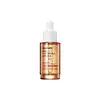What's inside
What's inside
 Key Ingredients
Key Ingredients

 Benefits
Benefits

 Concerns
Concerns

 Ingredients Side-by-side
Ingredients Side-by-side

Water
Skin ConditioningButylene Glycol
HumectantNiacinamide
SmoothingPolyglycerin-3
HumectantMethylpropanediol
Solvent1,2-Hexanediol
Skin ConditioningGlycereth-26
HumectantGlycerin
HumectantMannitol
HumectantSodium Dna
Skin ConditioningPolyglyceryl-10 Laurate
Skin ConditioningMicrocrystalline Cellulose
AbsorbentAmmonium Acryloyldimethyltaurate/Vp Copolymer
Polyacrylate Crosspolymer-6
Emulsion StabilisingAcrylates/C10-30 Alkyl Acrylate Crosspolymer
Emulsion StabilisingArginine
MaskingZea Mays Starch
AbsorbentMilt Extract
Skin ConditioningEthylhexylglycerin
Skin ConditioningMica
Cosmetic ColorantAllantoin
Skin ConditioningCaprylyl Glycol
EmollientAdenosine
Skin ConditioningParfum
MaskingBiosaccharide Gum-1
HumectantCI 77492
Cosmetic ColorantSodium Hyaluronate
HumectantTranexamic Acid
AstringentCalcium Pantothenate
Maltodextrin
AbsorbentSodium Starch Octenylsuccinate
AbsorbentSodium Ascorbyl Phosphate
AntioxidantTocopheryl Acetate
AntioxidantPyridoxine Hcl
Skin ConditioningHydrolyzed Hyaluronic Acid
HumectantHydrolyzed Sodium Dna
Skin ConditioningHyaluronic Acid
HumectantSodium Acetylated Hyaluronate
HumectantTripeptide-1
Skin ConditioningAcetyl Hexapeptide-8
HumectantWater, Butylene Glycol, Niacinamide, Polyglycerin-3, Methylpropanediol, 1,2-Hexanediol, Glycereth-26, Glycerin, Mannitol, Sodium Dna, Polyglyceryl-10 Laurate, Microcrystalline Cellulose, Ammonium Acryloyldimethyltaurate/Vp Copolymer, Polyacrylate Crosspolymer-6, Acrylates/C10-30 Alkyl Acrylate Crosspolymer, Arginine, Zea Mays Starch, Milt Extract, Ethylhexylglycerin, Mica, Allantoin, Caprylyl Glycol, Adenosine, Parfum, Biosaccharide Gum-1, CI 77492, Sodium Hyaluronate, Tranexamic Acid, Calcium Pantothenate, Maltodextrin, Sodium Starch Octenylsuccinate, Sodium Ascorbyl Phosphate, Tocopheryl Acetate, Pyridoxine Hcl, Hydrolyzed Hyaluronic Acid, Hydrolyzed Sodium Dna, Hyaluronic Acid, Sodium Acetylated Hyaluronate, Tripeptide-1, Acetyl Hexapeptide-8
Aloe Barbadensis Leaf Juice
Skin ConditioningRubus Villosus Fruit Extract
AstringentVaccinium Angustifolium Fruit Extract
Skin ProtectingMorus Nigra Leaf Extract
Skin ConditioningCucumis Sativus Fruit Extract
EmollientDaucus Carota Sativa Root
Skin ConditioningCalendula Officinalis Flower
Skin ConditioningCaprylic/Capric Triglyceride
MaskingCitrus Aurantium Dulcis Peel Extract
Emulsion StabilisingBorago Officinalis Seed Oil
EmollientPanthenol
Skin ConditioningGlycerin
HumectantArgania Spinosa Kernel Oil
EmollientSodium Ascorbyl Phosphate
AntioxidantAllantoin
Skin ConditioningHydrolyzed Dna
Skin ConditioningAdenosine
Skin ConditioningRetinol
Skin ConditioningPalmitoyl Tripeptide-38
Skin ConditioningXanthan Gum
EmulsifyingHydroxyethylcellulose
Emulsion StabilisingCarbomer
Emulsion StabilisingDimethicone
Emollient1,2-Hexanediol
Skin ConditioningEthylhexylglycerin
Skin ConditioningAloe Barbadensis Leaf Juice, Rubus Villosus Fruit Extract, Vaccinium Angustifolium Fruit Extract, Morus Nigra Leaf Extract, Cucumis Sativus Fruit Extract, Daucus Carota Sativa Root, Calendula Officinalis Flower, Caprylic/Capric Triglyceride, Citrus Aurantium Dulcis Peel Extract, Borago Officinalis Seed Oil, Panthenol, Glycerin, Argania Spinosa Kernel Oil, Sodium Ascorbyl Phosphate, Allantoin, Hydrolyzed Dna, Adenosine, Retinol, Palmitoyl Tripeptide-38, Xanthan Gum, Hydroxyethylcellulose, Carbomer, Dimethicone, 1,2-Hexanediol, Ethylhexylglycerin
 Reviews
Reviews

Ingredients Explained
These ingredients are found in both products.
Ingredients higher up in an ingredient list are typically present in a larger amount.
1,2-Hexanediol is a synthetic liquid and another multi-functional powerhouse.
It is a:
- Humectant, drawing moisture into the skin
- Emollient, helping to soften skin
- Solvent, dispersing and stabilizing formulas
- Preservative booster, enhancing the antimicrobial activity of other preservatives
Adenosine is in every living organism. It is one of four components in nucleic acids that helps store our DNA.
Adenosine has many benefits when used. These benefits include hydrating the skin, smoothing skin, and reducing wrinkles. Once applied, adenosine increases collagen production. It also helps with improving firmness and tissue repair.
Studies have found adenosine may also help with wound healing.
In skincare products, Adenosine is usually derived from yeast.
Learn more about AdenosineAllantoin is a soothing ingredient known for its protective and moisturizingg properties. Because of this, it is often added to products with strong active ingredients.
Studies show higher concentrations of this ingredient can promote wound healing.
Though it can be derived from the comfrey plant, allantoin is produced synthetically for cosmetic products to ensure purity.
Learn more about AllantoinEthylhexylglycerin (we can't pronounce this either) is commonly used as a preservative and skin softener. It is derived from glyceryl.
You might see Ethylhexylglycerin often paired with other preservatives such as phenoxyethanol. Ethylhexylglycerin has been found to increase the effectiveness of these other preservatives.
Glycerin is already naturally found in your skin. It helps moisturize and protect your skin.
A study from 2016 found glycerin to be more effective as a humectant than AHAs and hyaluronic acid.
As a humectant, it helps the skin stay hydrated by pulling moisture to your skin. The low molecular weight of glycerin allows it to pull moisture into the deeper layers of your skin.
Hydrated skin improves your skin barrier; Your skin barrier helps protect against irritants and bacteria.
Glycerin has also been found to have antimicrobial and antiviral properties. Due to these properties, glycerin is often used in wound and burn treatments.
In cosmetics, glycerin is usually derived from plants such as soybean or palm. However, it can also be sourced from animals, such as tallow or animal fat.
This ingredient is organic, colorless, odorless, and non-toxic.
Glycerin is the name for this ingredient in American English. British English uses Glycerol/Glycerine.
Learn more about GlycerinSodium Ascorbyl Phosphate is a form of Vitamin C. It is the salt of ascorbic acid.
This ingredient is more gentle than ascorbic acid. It is also more stable when exposed to light and oxygen.
Vitamin C helps reduce redness, improve skin texture, reduce the effects of aging, reduce the visibility of dark spots, and brighten skin.
Your skin uses Vitamin C to produce collagen and collagen production plays a role in having a strong skin barrier and plump skin. As an antioxidant, this ingredient also helps reduce the signs of aging such as fine-lines and wrinkles.
VItamin C helps brighten skin by blocking the process of skin darkening.
In a 2011 study, Sodium Ascorbyl Phosphate was found to have antibacterial properties. This may help treat acne.
Read more about other types of Vitamin C:
Learn more about Sodium Ascorbyl Phosphate